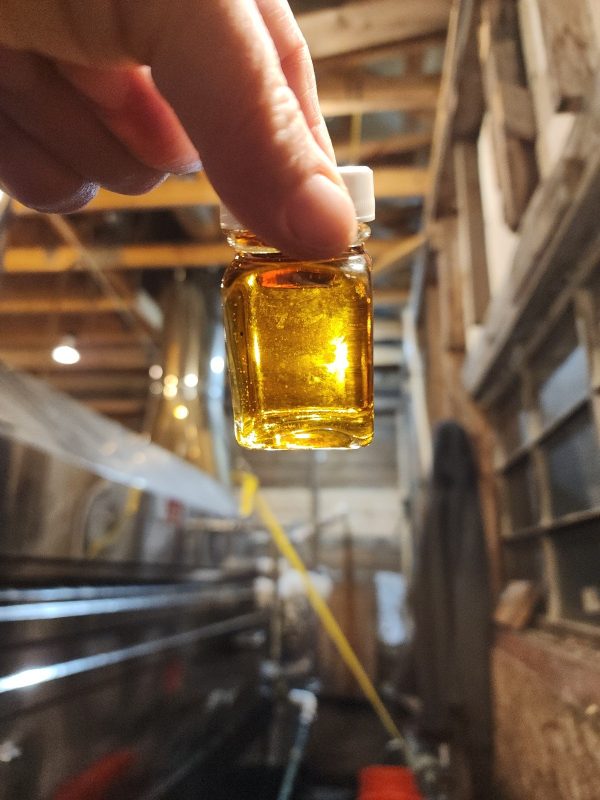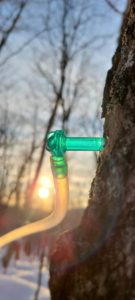March 17- April 11
3 weeks is all we had to boil this year. We’ve made about 80% of a crop. Part of the crop we will wholesale, but we can keep as much as we want so we’ll have plenty of maple syrup for the year. Happily we will also have Delicate, Rich and Robust available. I will be working this week to update the website, so nothing is listed as out of stock. If you find that – please let me know so I can fix it!
I want to apologize to any and all that have had to wait on an order. While I have so so much help, especially from family, I’m still the primary website/order/packaging person, I’m also the main tapper and boiler. I’m behind. I have managed to find my desk, I’m sending a lot of packages out today. I know I also need to clean my inbox as I had several special request which I am making a priority this week.
Why am I so behind – the family will tell you it’s because I have too much on my plate, which may hold some validity, but currently the reason is because when the sap runs, we have to process it as soon as possible. We start tapping in January and into February, and this year into March. February we had a tremendous amount of snow fall, which was great as it brought a lot of people to stay in our cabin, but was so hard to work in. Some days we literally were wading from tree to tree to tap. Snow shoes only worked part of the time. We were busy trying to finish tapping during the first run of the season when we should have been checking for leaks.
What does “Checking for Leaks Mean?
Once the sap started running we spend hours walking the lines, checking for leaks. Let me back up. Modern sugaring is all done using a system of tubing strung together. The tubing stays up all the time, strung from tree to tree using special fittings. Every year we use a new spout, drill a hole in the tree, pound the spout in. This allows the sap that comes from the tree to flow through the tubing. The tubing is 5/16th in diameter, this connects to a 1″ main line. We have hundreds of 5/16th lines, called laterals, that connect to the 1″ main lines. These mainlines feed into an 1 1/2 main line that is part of what we refer to as a wet/ dry system Then wet dry system consist of 2 lines that run parallel to the ground and each other, the wet line is where the sap flows, the dry line is air from our vacuum system in the sugar house. The 2 lines are connected at every 1″ main line junction. The air helps pull the sap from the trees, into the lines and go to the sugar house.
Yes, this does cause some very mild stress to the maple tree (more later about that). With miles of lines and hundreds of connections, there are going to be “leaks”. Primary cause are squirrels or coyotes chewing on lines, trees falling on lines, human error in not tapping a tree.
All of these small problems have to be fixed to create an air tight system so our vacuum system can work to it’s best capacity. The better vacuum we have, the more sap we can pull, the more syrup we can make. Depending on the sweetness of the sap, typically 2-3%, it takes 40-60 gallons of sap per 1 gallon of syrup.
When is the Harvest Season?
The harvest season can be anywhere between February and April. As we start to get a cycle of warm days and cold nights or above and below freezing temperature, the sap begins to rise from the roots of the trees. It’s flowing upward towards the tree limbs and the buds and leaves that will form. The sap feeds the leaves. We harvest a tiny percent of the sap that flows through the tree. Remember a tree is at least 10″ in diameter before we start tapping and we are using 1 tap or hole that is 5/16th round and about an inch deep per tree. The season ends when the sap stops flowing which is about the same time that the buds are forming. The trees will take on a red hue as the buds mature. The flavor is the sap changes from sweet to “buddy”. Then we’re done. This year our season lasted from March 17th to April 11th. Short, sweet and pretty intense at times! A couple of days the sap just poured in.
How much stress do you put on the trees?
We do our best to minimize stress, over the years the size of the spout, or hole that we put in the tree has decreased. Back when I was a kid, the size of the hole was about the size of my thumb, today it’s the size of my ring finger. I am reading up on a smaller tap and may be downsizing again this year after reading a few more studies. The good news? Maple trees are incredibly resilient! As soon as I pull the spout from the tree (I’m also the main spout puller person, but it’s one of my favorite jobs all year ssshhh don’t tell the rest), as soon as that spout is pulled, the hole starts to heal itself! Within a few years you have to look to find the old holes.
We look for the old holes as we tap, we also make sure that we have good white healthy looking shavings when we put in a new hole. Old crumbly brown shavings indicate a bad spot and we move to a new spot. Maples are about 40 years old, or as least 10″ in diameter before we tap the first time. We can continue to tap the same tree for at least another 40 years. Yes this means that I’ve tapped some trees over and over and over and over again. I can also say that if I was a maple tree I would be in my prime. (I did not feel that as I was trying to tap this year).
How did we manage to have Delicate, Rich and Robust this year?
That one we have no control over. Mother Nature and the Maple Trees give us what they want us to have each year and we accept it as is. Yes there are a few variables, like we keep the sap as cold as we can, boil it as soon as we can. Also we keep our storage tanks clean and try to boil the sap through the pans as quickly as we can.
We actually started the year (we being collective and the same across our fellow sugar makers) making Robust. It wasn’t until the end of week 2 before the color began to lighten. Then it stayed between Delicate and Rich the rest of the season. Why do I want one color versus another color? There are slight taste variations between colors and grades. In general the lighter the color, the lighter the flavor. I tend to have some of each kind in my kitchen. I will use darker, rich or robust for cooking or adding to foods such as yogurt and coffee. I prefer delicate on my waffles and we use delicate to make our candy. I will use Rich anywhere, table use to cooking, robust I will use for baking and cooking, beans, breads, marinades etc.
Regardless of the color, syrup has to meet strict guidelines to be considered Vermont Maple Syrup. It must be between 66.5 and 68 brix (the scale used to measure the amount of sugar in water.) I’ve heard there’s other areas that make syrup, but this is VERMONT maple and yes we’re proud of our maple and have high standards. Personally I can tell you that if I won’t serve my maple on my table I won’t sell it to anyone.
And this is why I’m behind….. I was going to send a quick update and ended up probably overloading you with info! I’m going to quit now and start packing orders. I will pick back up on another blog about more things maple!





